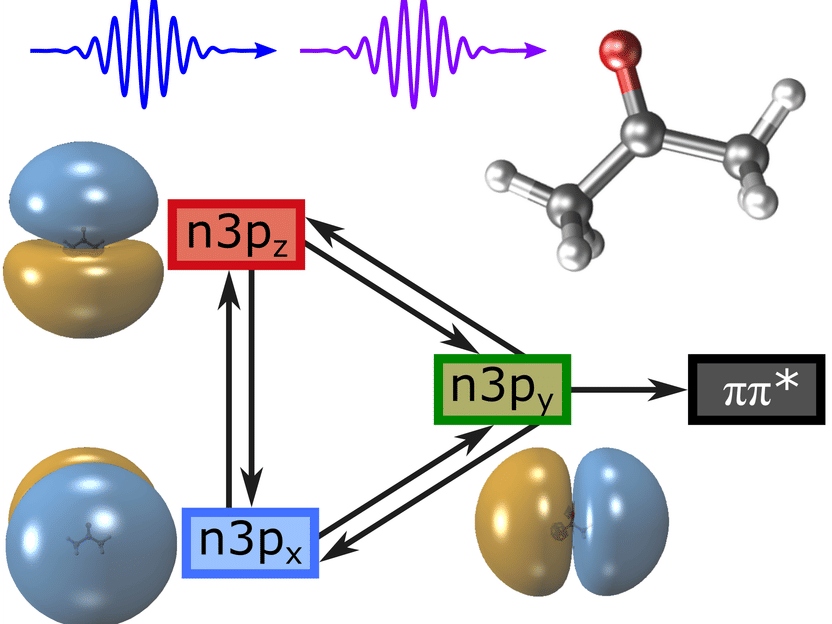New simulation-experiment combination allows deeper insights into ultrafast light-induced processes
Researchers from Graz University of Technology and the University of Vienna are demonstrating for the first time how the energy flow between strongly interacting molecular states can be better described.

The Graz femtosecond experiment (top) excites acetone molecules with a first laser pulse and queries their temporal evolution with a second pulse in order to measure the energy flow in the molecule. Quantum simulations from Vienna provide the electron distribution of the excited states (bottom) and their time-dependent compositions, which provides more precise information about the energy flow and allows comparisons with the experiment.
© IEP – TU Graz
Since the 1990s, femtochemistry has been researching ultrafast processes at the molecular level. In the last few years, the research group Femtosecond Dynamics at TU Graz’s Institute of Experimental Physics has been able to achieve a number of successes in the area of light-matter interaction. “A precise understanding of the processes triggered by photoexcitation in molecules is, for example, a prerequisite for the development of sustainable technologies that enable an energy supply based on solar energy,” says Markus Koch, the head of the working group. As an example, he cites photocatalysis, which helps to convert sunlight into chemical energy with advantages in terms of long-term storage and energy density when compared to the generation of electrical energy via photovoltaics.
One method for such molecular dynamic investigations makes use of so-called pump-probe measurements applying an ultrashort laser pulse to excite (“pump”) a molecular system into a desired state. After an adjustable delay time, a second (“probe”) laser interrogates the population of the excited state by ionizing the molecule. The energy of the emitted photoelectrons is measured and by varying the pump-probe delay time, conclusions can be drawn about the energy flow in the molecule.
Heisenberg's energy-time uncertainty principle prevents exact results
An exact description of light-induced processes on their real time scale has so far failed for some polyatomic molecules that may take different decay or fragmentation routes after excitation, depending on the choice between closely spaced energy states. As a result of Heisenberg’s energy-time uncertainty principle, laser pulses of only femtosecond (10-15 seconds) time duration cannot selectively excite closely neighbouring molecular states. However, short pulses are a prerequisite for the observation of extremely fast processes.
New approach combines theory and experiment
In collaboration with researchers of the Institute of Theoretical Chemistry at the Faculty of Chemistry of the University of Vienna under the direction of Prof. Leticia González, the experimental physicists in Graz have now overcome this hurdle. By combining experiments with ultrashort laser pulses and theoretical simulations of light-induced processes, the energy flow in acetone – a molecule that has already been well studied – could now be observed for the first time at a key energy window between three closely related states. Even for the Vienna group, a driving force in the field of the theoretical description of molecules after light excitation, the system under investigation presented a challenge. “For these simulations, new developments in our local software package SHARC were necessary, without which the correct description of acetone dynamics would not have been possible,” emphasizes González.
Synergy effects yield new insights
Both methods in themselves are widely used, but “while the energy-time-blur relation in femtosecond spectroscopy prevents precise results, real-time simulations provide deeper insights into molecular dynamics, which in turn require the experimental results to be verified,” explains Koch. The combination of these two techniques now provides researchers with a deeper insight into acetone dynamics and is a further milestone in the study of light-matter interactions.
Original publication
See the theme worlds for related content
Topic World Spectroscopy
Investigation with spectroscopy gives us unique insights into the composition and structure of materials. From UV-Vis spectroscopy to infrared and Raman spectroscopy to fluorescence and atomic absorption spectroscopy, spectroscopy offers us a wide range of analytical techniques to precisely characterize substances. Immerse yourself in the fascinating world of spectroscopy!

Topic World Spectroscopy
Investigation with spectroscopy gives us unique insights into the composition and structure of materials. From UV-Vis spectroscopy to infrared and Raman spectroscopy to fluorescence and atomic absorption spectroscopy, spectroscopy offers us a wide range of analytical techniques to precisely characterize substances. Immerse yourself in the fascinating world of spectroscopy!
























































